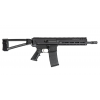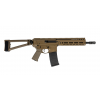
I’m dedicated to pushing PSA’s JAKL and Sabre-15 rifles to their limits. I don’t want to load mags and spew ammo at the berm. That seems like a great way to waste time and ammo. I want to push those rifles, but I also want to get some good training. This brings me to shooting drills, and with that in mind, I figured it would be wise to catalog these drills and share them with our readers. We will start with the Viking Tactics VTAC 1-5 drill.
Kyle Lamb, former SFOD-1 alumni, and owner of Viking Tactics, designed the VTAC 1-5 drill. The drill is designed to be shot with a rifle, but it’s easy to see how you could also use a pistol to conduct the drill. Since it’s designed for a rifle, and I’m testing rifles, we’ll be sticking with the JAKL today.
Gear, Ammo, and More
For each run of this drill, we’ll need fifteen rounds. With a standard-capacity magazine, you can shoot the drill twice before needing to reload. You’ll need three targets, preferably USPSA or VTAC’s own targets. I used the FBI Q targets since I had them on hand.

You want to use the USPSA or VTAC targets because they have a dedicated chest box that demands more accuracy than most. You can also replicate the 5.9 x 11-inch rectangle of the A-zone onto any target with a Sharpie and a ruler.
Next, you’ll need your weapon, magazine, and basic PPE. For my run, I used the JAKL with a SIG Romeo-MSR red dot. We’ll also need a shot timer or, at the very least, a half-decent app on your phone to provide you with a par time. That’s it. The drill doesn’t take much.
Range Setup
The range setup isn’t too difficult. We’ll need to set up three targets approximately one yard apart in a line. The shooter will be five yards from the target. Ensure you have an adequate backstop behind the targets.

Shooting the Drill
You’ll engage the targets from left to right. Your leftmost target is Target 1, the middle is Target 2, and the right-most target is Target 3. Start in your chosen ready position. At the beep, aim and fire one round onto target 1, two rounds onto target 2, and three rounds onto target 3. Now you’ll transition back to target 2 and fire four more rounds into it, and finalize the drill by transitioning to the first target and delivering unto it your last five rounds.

Here is what it looks like to make it a little easier to understand.
- T1 – 1 Round
- T2 – 2 Rounds
- T3 – 3 Rounds
- T2 – 4 Rounds
- T1 – 5 Rounds
You aim to fire those fifteen rounds between three targets with five transitions in less than five seconds. You want your rounds to land in the USPSA A-Zone or into the square on the VTACS target.

I did it in 5.25 seconds on my first cold run, effectively failing the drill. My goal is always performance on demand, and I wanted to pass on my cold run, but now I know that I need a little more practice to hit that cold run demand. The next run was a 4.8, and my times trickled down until my ammo stash was 90 rounds short of 5.56.

Like any intermediate caliber 5.56 rifle, the JAKL handles it with ease. The long-stroke gas piston system chugs along gently and delivers a fairly soft recoil impulse with a bit of forward movement as it settles into the forward position. It’s super easy to control, making running the VTAC 1-5 quick and easy.
Live Inventory Price Checker
|
|
PSA JAKL 5.56 Pistol, Black | Palmetto State Armory | $ 1099.99 |
|

|
PSA JAKL 5.56 Pistol, Black | Palmetto State Armory | $ 1099.99 |
|
|
|
PSA JAKL 5.56 Pistol, Flat Dark Earth | Palmetto State Armory | $ 1099.99 |
|

|
PSA JAKL 5.56 Pistol, Flat Dark Earth | Palmetto State Armory | $ 1099.99 |
|
Benefits of the VTAC 1-5
This short and sweet drill delivers less than five seconds of training, but somehow, in those five seconds, the VTAC 1-5 shoves a ton of training potential in. If you’re a fan of efficiency, then the VTAC 1-5 drill is for you.
First, the most obvious training benefit comes down to target transitions. You have to make five target target transitions. At first glance, the targets are seemingly large, but aiming at an internal square or rectangle is a bit tougher than hitting a full man-sized target. Your accuracy under a timer is also tested.

That timer gives us a sense of urgency and makes us try to shoot faster. The faster you shoot, the more recoil control you’ll have to execute, and that’s another benefit of running the VTAC 1-5.
You also get used to firing longer strings of fire. We often fall into the habit of firing one or two rounds and then clicking the safety back on. This gets you more used to firing and controlling longer strings of fire. It also gets you faster at firing longer strings of fire, which means you’re practicing jamming on that trigger quickly.

The VTAC 1-5 packs a lot of training into a short, light-on-ammo course of fire that’s a good bit of fun.
Going Fast
If you’re looking for a good way to turn 15 rounds of rifle ammo into a bit of noise, you could do much worse than the VTAC 1-5. This drill pushes you to be accurate, fast, and capable of letting loose an ever-increasing string of fire. Not only will you get a solid bit of training, but you’ll have a good bit of fun doing it. Give it a try, and let us know what you think.
About Travis Pike
Travis Pike is a former Marine Machine Gunner, a lifelong firearms enthusiast, and now a regular guy who likes to shoot, write, and find ways to combine the two. He holds an NRA certification as a Basic Pistol Instructor and is the world’s Okayest firearm’s instructor.








Practice under stress builds speed and accuracy. Running drills on a timer adds stress. Adding competition adds stress. SMOTH directly relates to speed. Skills are acquired by practice and muscle memory will disappear over time without it. Practice/train all you can, whenever you can. This is a good drill. I would add 1 yard each time I ran the drill until I could not make it in 5 seconds. This could also be done with a pistol. Another good drill is, “El Presidente”. This is 5 “A” zone targets at 1 yd. apart with 1 round in each from left… Read more »
Jeff Cooper opined on multiple attackers, “Everyone gets firsts before anyone gets seconds”.
I’ve never used a timer or done a drill.
But I’m reminded of a reprint I read of a Jeff Cooper article, where he was talking about how to prepare for a gun fight, short of actually being in one.
He said, that the best way to tell how you’d do in a gun fight, short of being in one, was to go big game hunting, for deer or elk, etc. He said if you can keep your buck fever under control, you’ll most likely be able to handle yourself in a gunfight.